
from
https://www.soundandvision.com/content/infocomm-new-cedia-expo
You’d think that will all the smart devices populating your home, your energy bill would spike through the roof. While that’s certainly possible, manufacturers from all sectors of the smart home industry have drastically reduced the energy glut over the years thanks to continual advancemennts in product designs.
A new Consumer Technology Association (CTA) study, Energy Consumption of Consumer Electronics in U.S. Homes in 2017, finds the number of tech devices in U.S. homes has increased 21 percent since 2010, but those devices now account for 25 percent less residential energy than they did then. This energy efficiency achievement is due to the consumer tech industry’s investments in lightweight materials and energy efficient technologies, as well as the convergence of multi-functional devices.
According to the study, there are now nearly 3.4 billion consumer tech devices across the country, consuming an estimated 143 terawatt-hours (TWh) of electricity annually, compared to 2010 when 2.9 billion devices (21 percent fewer than today) used 193 TWh of electricity (35 percent more than today).
“This study shows the increasing momentum to create consumer products that promote smarter lifestyles and lower energy consumption, while minimizing our impact on climate change,” says Gary Shapiro, president and CEO of CTA.
Largely responsible for the reduction of energy use are TVs. The annual in-home energy consumption of TVs declined 30 percent from 2013 to 2017, with the average cost to power a TV now less than five cents a day. Furthermore, from 2008 to 2015, about 80 percent of TVs shipped have met or exceeded the then-current Energy Star requirements.
During 2013 to 2017 the energy use of set-top boxes dropped nearly 20 percent. Much of the decline can be attributed to the Voluntary Agreement for Ongoing Improvements in the Energy Efficiency of Set-Top Boxes, an agreement by the pay TV and consumer technology industries to meet more efficient energy standards. The agreement is estimated to have saved consumers more than $2.1 billion since it was signed by the major pay TV service providers in 2013. A similar industry agreement for home Internet equipment has increased the energy efficiency of more than 98 percent of consumer broadband equipment purchased and sold in the U.S. in 2016.
The CTA Energy Consumption of Consumer Electronics in U.S. Homes in 2017 was produced by the Fraunhofer USA Center for Sustainable Energy Systems.
The post How Energy Efficient is Your Smart Home? appeared first on Electronic House.
Philips Hue light bulbs launched the colored lighting trend. With a quick tap of a button, the color of the light could switch on a dime. The effect adds ambiance and has even been proven to promote health and wellness. Now, Philips Lighting introduces a way to make your entertainment content more lively, engaging and exciting. And, if you’re ready to add some color to your yard, this summer Philips Hue will launch a new line of exterior lighting.
Find Philips Hue product here.
Following a free, over-the-air software update in December 2017, Philips Hue customers with color-capable lights and a Philips Hue V2 bridge can enjoy immersive home entertainment experiences. The new software synchronizes Philips Hue lights a variety of content. Razer, a gaming brand, is the first Philips Hue partner to go live with the feature.
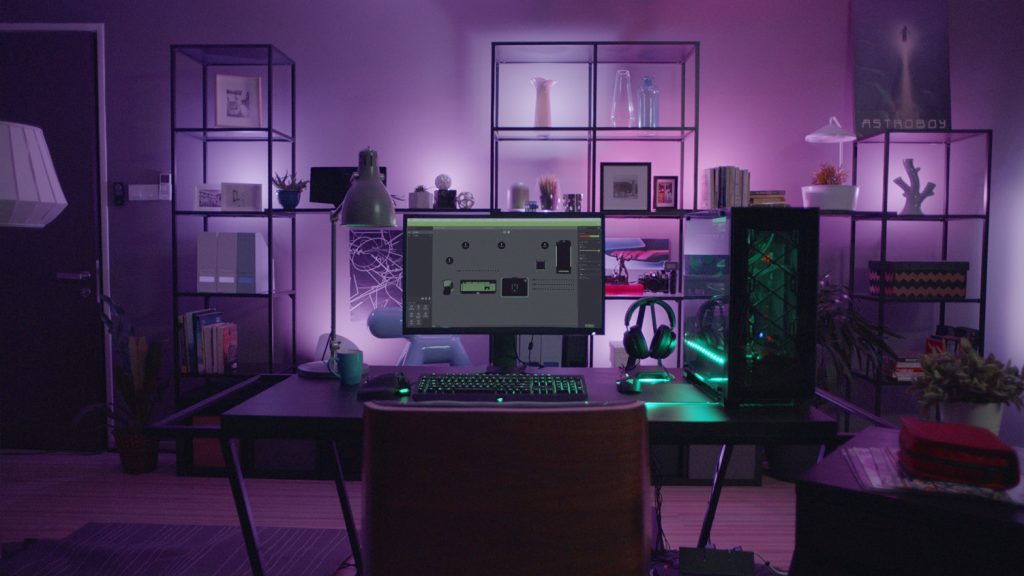 Also, Philips Lighting will introduce later this year Hue Sync, an application that will run on any Windows 10 or macOS High Sierra-based computer. This will enable anything that’s playing on the computer-games, movies, music-to kick start the Philips Hue lights.
Also, Philips Lighting will introduce later this year Hue Sync, an application that will run on any Windows 10 or macOS High Sierra-based computer. This will enable anything that’s playing on the computer-games, movies, music-to kick start the Philips Hue lights.
 “Since the start, Philips Hue has been about turning everyday lighting into extraordinary experiences. We are taking this to the next level with the rollout of Hue Entertainment, the announcement of our first content partner, and the upcoming launch of the Hue Sync app,” says Chris Worp, business group leader, Philips Lighting. “Our first step is with gaming, the largest segment in the entertainment industry, followed by movie and audio integrations.”
“Since the start, Philips Hue has been about turning everyday lighting into extraordinary experiences. We are taking this to the next level with the rollout of Hue Entertainment, the announcement of our first content partner, and the upcoming launch of the Hue Sync app,” says Chris Worp, business group leader, Philips Lighting. “Our first step is with gaming, the largest segment in the entertainment industry, followed by movie and audio integrations.”
Also on tap for Philips Hue users is an update to the Hue app. Based on comments, feedback, and ideas from Philips Hue users, the redesign will enhance both existing and new features. The new interface will also enable consumers to instantly access their last used scenes, and to group lights and selected their desired color temperature and color.
The post Philips Hue Synchs with Music; New Outdoor Line Upcoming appeared first on Electronic House.
Careful planning is one of the most important aspects of adding smart technologies to a home. Determining the type of products that will suit the style and size of the home, as well as its inhabitants is part of the plan. So are determining how and those products and systems will be installed and configured. There are bound to be changes and adjustments along the way, but if you have a well-laid-out plan to follow, you’ll be able to adapt quickly and stay on track.

The bigger and more elaborate the home systems setup, the more important it becomes to stick to a plan, as the project can quickly spiral out of the control. That’s why home systems integration firms like London, UK-based Inspired Dwellings relies on software from D-Tools to take the project from proposal to completion with as few bumps in the road as possible. D-Tools walks the design and installation team through every phase of every project to minimize errors, track and maximize profitability, and ensure client satisfaction—as was the case with our featured home of the week.
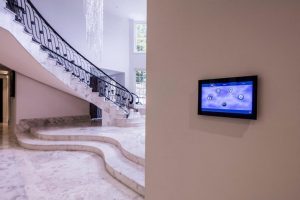
A family in Kent, UK, recently called on Inspired Dwellings to integrate the AV, data, lighting, heating and CCTV systems throughout their new luxury property. Because it was a new construction project, Inspired Dwellings had the benefit of working within the builder’s schedule to run wiring in open walls and achieve optimal placement of speakers for the whole home audio system, LED screens, and understated touch screens throughout the home to access the Control4 home automation system.
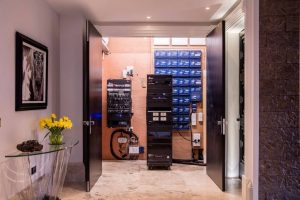
“The basis for this project was to have an integrated home system that was easy for the whole family to use,” says Rob Sutherland, managing director for Inspired Dwellings. “Utilizing D-Tools extensive product library, our design team worked tirelessly to ensure that we had all the most up to date technology while the A/V equipment was put together offsite in our workshop and tested to ensure a seamless installation at the customer’s home.”
Luxury With No Boundaries
The grand 12,000-square-foot home, which opens to a spacious foyer with a spiral staircase, includes a 14-seat home theater with three rows of chairs from Fortress Seating on risers for optimal sightlines, a JVC DLA-X500R 4K projector, and a 130-inch Screen Research screen.

All 14 rooms of the home feature distributed audio, while a family room boasts a 55-inch TV and surround sound system. Inspired Dwellings provided HDMI video distribution throughout the home and a Rako lighting system. An equipment closet houses a Middle Atlantic rack with a Control4 control system, Apple TV’s, a Sonos Zoneplayer, and centralized video sources including Blu-ray players and satellite set top boxes.
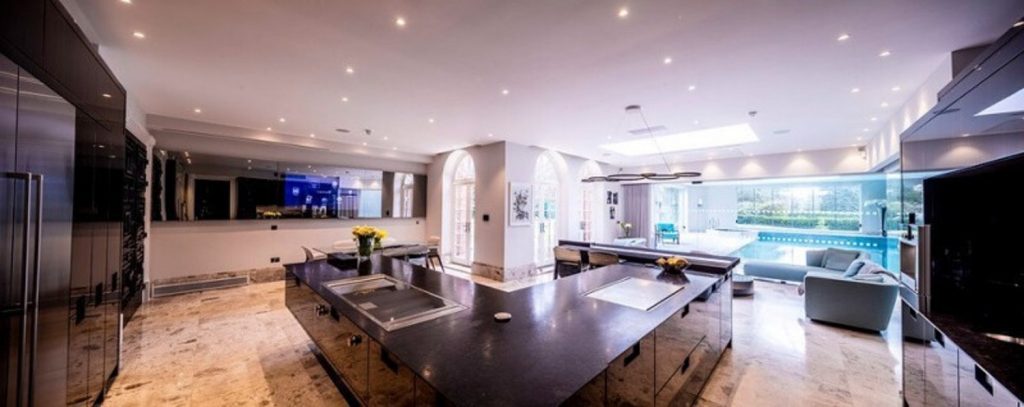 Inspired Dwellings was also tasked with providing the family’s data infrastructure with enough bandwidth to accommodate all the smart devices on the network, and a CCTV security system that spans the property, indoors and out.
Inspired Dwellings was also tasked with providing the family’s data infrastructure with enough bandwidth to accommodate all the smart devices on the network, and a CCTV security system that spans the property, indoors and out.
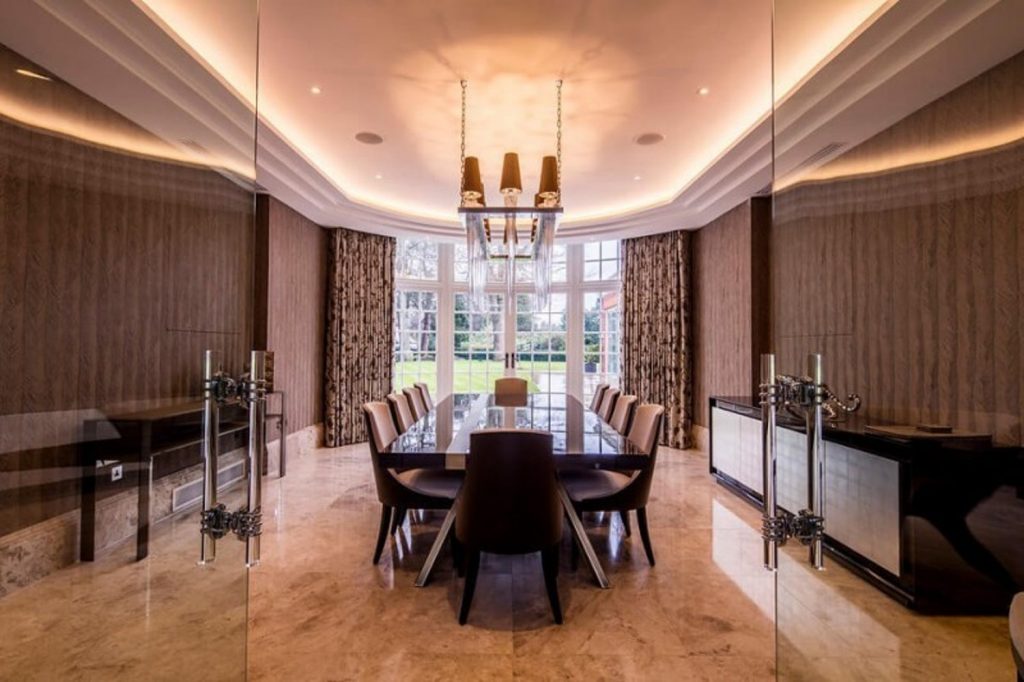
The Kent family working with Inspired Dwellings had a solid idea of what they wanted to accomplish and were specific in their request for it to include the latest technology. They were, however, open to suggestions that would make their home’s systems more user-friendly and enhance their overall technology experience.
 By using the D-Tools SI platform, Inspired Dwellings was able to quickly create a detailed yet simple estimate. “The client appreciated how quickly we were able to present an initial proposal,” says Sutherland. The estimate allowed the integration firm’s team to not just list out items and labor, but also show alternatives the client might choose. “By using the options within the proposal, we could show the client the price for items not included while helping our sales team facilitate any extras the client might want to add,” he explains.
By using the D-Tools SI platform, Inspired Dwellings was able to quickly create a detailed yet simple estimate. “The client appreciated how quickly we were able to present an initial proposal,” says Sutherland. The estimate allowed the integration firm’s team to not just list out items and labor, but also show alternatives the client might choose. “By using the options within the proposal, we could show the client the price for items not included while helping our sales team facilitate any extras the client might want to add,” he explains.
The family embraces technology in every aspect of their lives but didn’t want it to distract from the home’s beauty. Touchpanels sit unobtrusively on walls in common areas and bedrooms, but family members can also control the home’s systems through apps on their iPads and smartphones.
With so many different areas requiring cabling, wiring, and other equipment, the project could have gotten extremely complicated and hard to manage very quickly. D-Tools helped Inspired Dwellings keep it all under control.
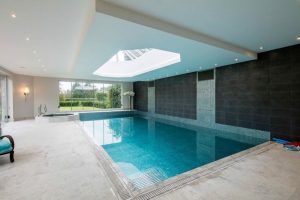
“Once the proposal was agreed by the client, D-Tools enabled a swift and easy transition from Sales to the Design, because the project database already had the items ready,” says Sutherland. “Using D-Tools drawing capabilities – vis integrated Visio – we can create cable schedules, plans, elevations, schematics and project information sheets using the information in the database. This not only saves us time, but ensures that the data is correct and to the specification that the sales rep and client have agreed. As our team started to work on this project, it was easy to locate products, rooms or systems that they were working on.”
Great technology paired with a streamlined and well-organized design and installation schedule, netted this family the smart home of their dreams. Products and systems blend in with the design and the Inspired Dwellings team was able to install each piece of the project with little disruption to the family. The process was smooth and the end result stunning.
The post London Smart Home a Stellar Example of Good Planning appeared first on Electronic House.
The X1 Xfinity Home remote has enabling consumers to use their voice to channel surf, search for specific programs, control the volume, and more recently to rewind and fast-forward on-demand and recorded movies and shows. But thanks the recent introduction of several “Works with Xfinity” program, products from big names like August, Honeywell, Kwikset, Lutron, Nest and others can now be controlled by uttering voice commands into the X1 remote. For example, saying “Good Night” could lock an August smart lock on the front door, turn off Lutron dimmer switches, adjust a Nest thermostat, and arm a Honeywell security system.
 “Xfinity will be the home operating system that integrates every IoT device and transforms a connected home into an intelligent home,” says Chris Satchell, Xfinity Home EVP and chief operating officer. “We also will add value to the experience by giving customers contextual suggestions for automation that will help them take full advantage of their digital home, making it more useful, fun, and enjoyable.”
“Xfinity will be the home operating system that integrates every IoT device and transforms a connected home into an intelligent home,” says Chris Satchell, Xfinity Home EVP and chief operating officer. “We also will add value to the experience by giving customers contextual suggestions for automation that will help them take full advantage of their digital home, making it more useful, fun, and enjoyable.”
In addition to delivering a voice command to devices via the X1 remote, you can use it to gather answers to questions, such as, “Xfinity Home, is the bedroom light on? or Xfinity Home what is the temperature?” You’ll see the answers to these questions right on the screen on your TV, without interrupting what you’re watching. You can also see feeds from surveillance cameras on the TV screen.
With the announcements from Xfinity Home, it’s not too late to add products that can prep your house for a great Superbowl party. Then, with commands like these you can create the perfect viewing environment:
Xfinity Home make the lights green (if you’re a Philly fan)
Xfinity Home make the lights red or blue (if you’re a New England fan)
Xfinity Home show me the front door camera (to check for your pizza delivery)
The post Xfinity Home X1 Voice Remote Now Controls Philips Hue Lights, Nest Thermostat appeared first on Electronic House.
Smart locks are taking the home systems marketplace by storm. Here are 10 really good reasons why you should add one to your house today.
One of the key (no pun intended) attributes of a smart lock is its ability to be locked and unlocked without using a traditional key. No more digging around in pockets and purses—instead you just punch in a “secret” code to disengage the lock. This feature is particularly useful for kids arriving home from school. Some locks are able to recognize the Bluetooth signal from your smartphone to unlock the door.

Each person in your family can be assigned his or her own entry code. You can view a log via an app that comes free with most smart locks to monitor who entered or exited the home and when. Did your teenage daughter come home after curfew? You can see exactly when she unlocked the door for proof.
One of the biggest hassles of homeownership is dealing with maintenance issues. Hustling home from work to let in the repairman is disruptive to your day. With a smart lock you can assign the repairman, painter, babysitter, out of town guests, whoever, a temporary access code. You can select a specific activation and deactivation day and time for the code; for example, the code used by your dog walker could be set to only work between the hours of noon and 2, Monday through Friday.
Via Wi-Fi you can receive an alert on your smartphone when the lock is disengaged and engaged both guests with temporary access and members of the household with full-time access.
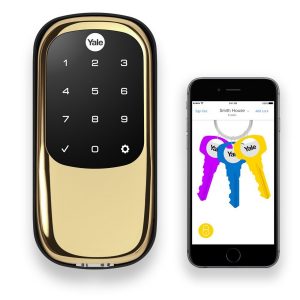
Smart locks are noted as being “unpickable,” and manufacturers have incorporated technologies that make the locks virtually tamper-proof.
You can spruce up the exterior of your house in seconds by swapping the old-fashioned mechanical lock with a sleek, touchscreen-style door lock.
Priced at around $250, a smart lock is an affordable investment that will last for years to come.
 Many smart locks are designed to be installed by handy homeowners. You can add one at your leisure and take pride in the fact that tackled this home improvement project yourself.
Many smart locks are designed to be installed by handy homeowners. You can add one at your leisure and take pride in the fact that tackled this home improvement project yourself.
Amazon shook things up this holiday season by introducing a special delivery service to Prime members that granted delivery people access to a temporary code on a smart lock so they could deposit packages safely inside your home. Expect this trend to continue with other retailers joining the bandwagon.
A smart lock can and in most cases should be the cornerstone of a complete home control system. Its status (locked or unlocked) can signal other devices—like thermostats and lights—to adjust accordingly. Smart products in your house can also react based on the access code that was entered.
For anyone who regularly forgets to lock the door before getting into bed, the ability to lock the door via voice command is a huge convenience. You can also do this via a mobile app, but by voice is virtually effortless. Manufacturers are increasingly adding this capability to their locks.
The post 10 Reasons You Should Buy a Smart Lock appeared first on Electronic House.
By Zachary Lloyd
If you are looking for a portable video projector with a range of features for both entertainment and business applications, you have probably come across the Intelligo by Optoma. Out of the box this projector comes with a very sturdy carrying case, some A/V cables, an HDMI cord, a power adaptor, and a remote. The projector itself is fairly small and easily portable, with a matte silver, plastic construction. While it may not feel quite as nice as a piece of metal, the plastic allows the projector to remain light, which is good for carrying it to a business meeting or to the back yard. Furthermore, it has rubber feet on the bottom to prevent it from slipping around wherever it is placed.
 The setup for the Intelligo was quick and painless. It runs a heavily modified version of Android, which means that it has an extensive GUI (graphic user interface) to use. The setup seemed to want to be used with the remote, which while it feels good in the hand and has very good button placement, has its share of obstacles. The IR receiver on the projector is on the front of the unit, so when sitting next to it or behind it, you will be craning around to get the remote to work properly.
The setup for the Intelligo was quick and painless. It runs a heavily modified version of Android, which means that it has an extensive GUI (graphic user interface) to use. The setup seemed to want to be used with the remote, which while it feels good in the hand and has very good button placement, has its share of obstacles. The IR receiver on the projector is on the front of the unit, so when sitting next to it or behind it, you will be craning around to get the remote to work properly.
The first step in the setup is to connect to the WiFi, which was super quick. However, I did find that upon a restart, it took a very long time to reconnect. After a quick setup, I headed straight to the Android Play Store for some fun and downloaded Netflix to give the projector a go.
The projector proved super simple to use, as you can plug a PC or cable box into it, or you can use the built in apps. Moreover, the app I mainly used was Netflix, as most other scenarios were simply easier with a PC. I found that while the quality of the screen the projector threw out was okay, it did not get super bright, so if there is an ambient light issue, you will have trouble seeing images rendered by the projector. It also is only 720p, so the resolution is not as high as other readily available technologies. Furthermore, the built-in speaker is completely unusable. My unit had a rattle in it, and the speaker was very soft and muddy sounding. It also did not get nearly loud enough to fill the room where the projector was being utilized.
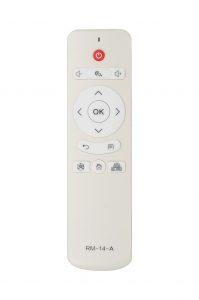 However, being able to use Netflix on a near 100-inch display without needing to buy an expensive TV was very nice, and quickly became something of a creature comfort. I did find that a lot of the apps threw an error regarding Google Play Services and then restarted, so the software could definitely use some work. For the latter half of my testing, I plugged a Beats Pill into the aux port on the back, and used my laptop over HDMI to see how it would perform in a more business-like setting. Viewing PowerPoints or short videos on the projector is a breeze, and is one of the few situations where it is genuinely better than having to plug a laptop into a TV.
However, being able to use Netflix on a near 100-inch display without needing to buy an expensive TV was very nice, and quickly became something of a creature comfort. I did find that a lot of the apps threw an error regarding Google Play Services and then restarted, so the software could definitely use some work. For the latter half of my testing, I plugged a Beats Pill into the aux port on the back, and used my laptop over HDMI to see how it would perform in a more business-like setting. Viewing PowerPoints or short videos on the projector is a breeze, and is one of the few situations where it is genuinely better than having to plug a laptop into a TV.
Overall, this projector is pretty good, and comes with all the features that a very nice Smart TV would have, but at a fraction of the cost, plus it is far more portable for an on-the-go user. While the display is only 720p, for a portable projector, it is very nice, and I can safely recommend it to people who are in the market for this niche product.
The post Review: Optoma Intelligo Portable Video Projector appeared first on Electronic House.
One of the best ways to deter burglars and vandals is to make your house seem occupied and active. But how do you accomplish this while you’re away on vacation, short of hiring a house sitter? A new device from Mitipi promises to give your vacant home a dose of domestic reality. It can make your house seem like someone is there when in fact you might by miles away on a business trip or basking in the sun on a sandy beach.
The simple standalone tabletop device, dubbed “Kevin” incorporates a speaker and LED lights and sensors to learn the usual patterns of household activity and play them back when no one is at home. Plenty of products and technologies today can learn how lighting is used throughout the day, and then mimic that behavior through the lighting-control system. But here we have a practical standalone system that doesn’t require smart lights to create a lived-in look.
Kevin captures lighting scenes through ambient light sensors, and listens to sounds through a microphone array. Analyzing these inputs enables Kevin to play back lights and sounds as they might occur on any given day– just as a roomate might. Furthermore, it can learn any repetitive associations between light and sound and use that knowledge during unattended playback.
For example, the device might learn that the sound of a door knock typically is followed by the sound of a dog barking and the brightening of the space. In an empty house, the device would respond similarly when it senses a knock on the door — the virtual dog barks and LEDs turn on.
Through an app, you can tell the Wi-Fi enabled device when you’re leaving, and it will play back sounds and trigger lighting that might seem normal to any stalker. The sound and lighting come from the device itself — not connected speakers or bulbs — but that’s OK because you can spread the Wi-Fi-enabled things around the house where lights might be visible (exterior rooms) or sound might be hearable (near front door, for example).
The simulated routines are randomized around your usual schedule, so someone scouting your neighborhood won’t get recognize that the dog barks every day at 2:00 p.m. and the bathroom light stays on from 6:00 to 7:00.
The post Smart Home Security Device Mimics Your Routines appeared first on Electronic House.
Smart locks have been widely available for some time for the front door. And that’s a good thing given the fact that most break-ins happen through the front door. To offer even greater home protection, Yale Locks & Hardware brings the security and convenience of its keyless electronic locks exclusively to Andersen hinged patio doors.
The Yale Assure Lock is a sleek new keyless lock featuring Z-Wave for compatibility with a wide range of smart home platforms, and Bluetooth for key free unlocking. It offers voice control via Alexa when used in conjunction with a smart home hub, and can be unlocked by entering a PIN code using the lock’s backlit touchscreen.
“By extending keyless, electronic control to patio doors, our new Assure Lock provides homeowners with a whole new level of control over their homes,” says Jason Williams, president, ASSA ABLOY U.S. Residential Group, which includes Yale Residential. “And we’re very pleased to have worked with Andersen on the development of these locks for their industry-leading line of hinged patio doors.”
The new Assure Lock is a slender lever lock that is compatible with Andersen’s Architectural Collection hinged patio doors. Its slim, low-profile one-piece design complements the Andersen doors, regardless of style, to enhance both their appearance and function.
The lock is easily integrated into a Z-Wave smart home or alarm system to provide remote operation of the lock from anywhere, and, thanks to Andersen’s VeriLock Security Sensors technology, can alert the homeowner whether their patio doors are open, closed, locked or unlocked via a self-monitoring or professional monitoring system.
“This is a great next step for Andersen’s Verilock technology. Our customers can not only monitor the status of their patio doors, they can now take action on remotely locking or unlocking their hinged patio doors,” says Rob Garofalo, senior business manager of Andersen’s Architectural Collection product.
A companion Yale Assure app allows homeowners to send digital keys to others, control when each digital key holder has access, view recent access history, and permanently revoke a digital key at any time. Unlocking the Assure Lock with a smartphone is easy – a patented unlocking method called Twist & Go prevents unintended unlocking by requiring the user to rotate the phone 90 degrees before tapping the check mark on the keypad.
The new Yale Assure Lock for Andersen hinged patio doors will be available in March 2018 and priced between $400 and $450.
The post New Yale Smart Lock Designed to Secure Andersen Hinged Patio Doors appeared first on Electronic House.